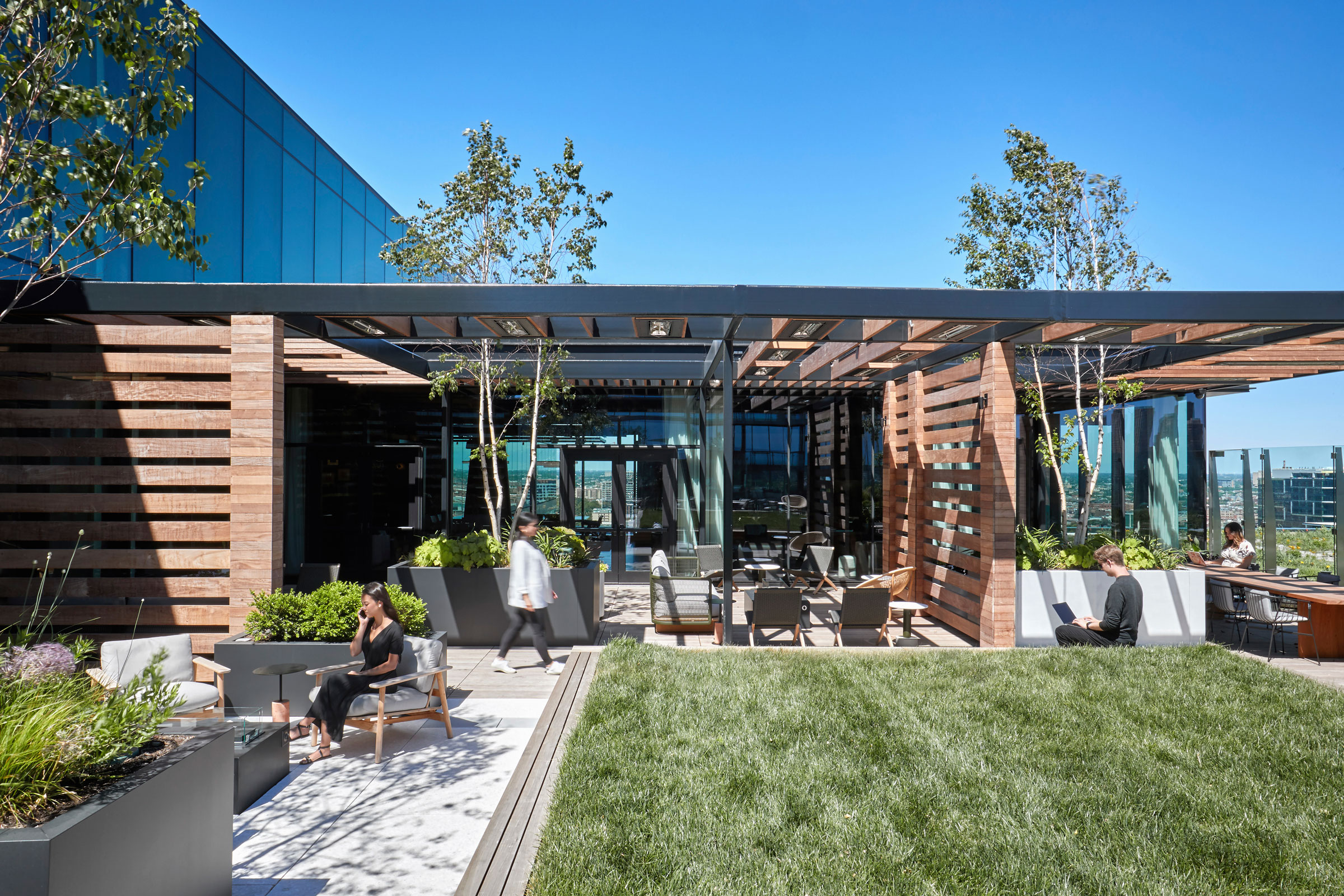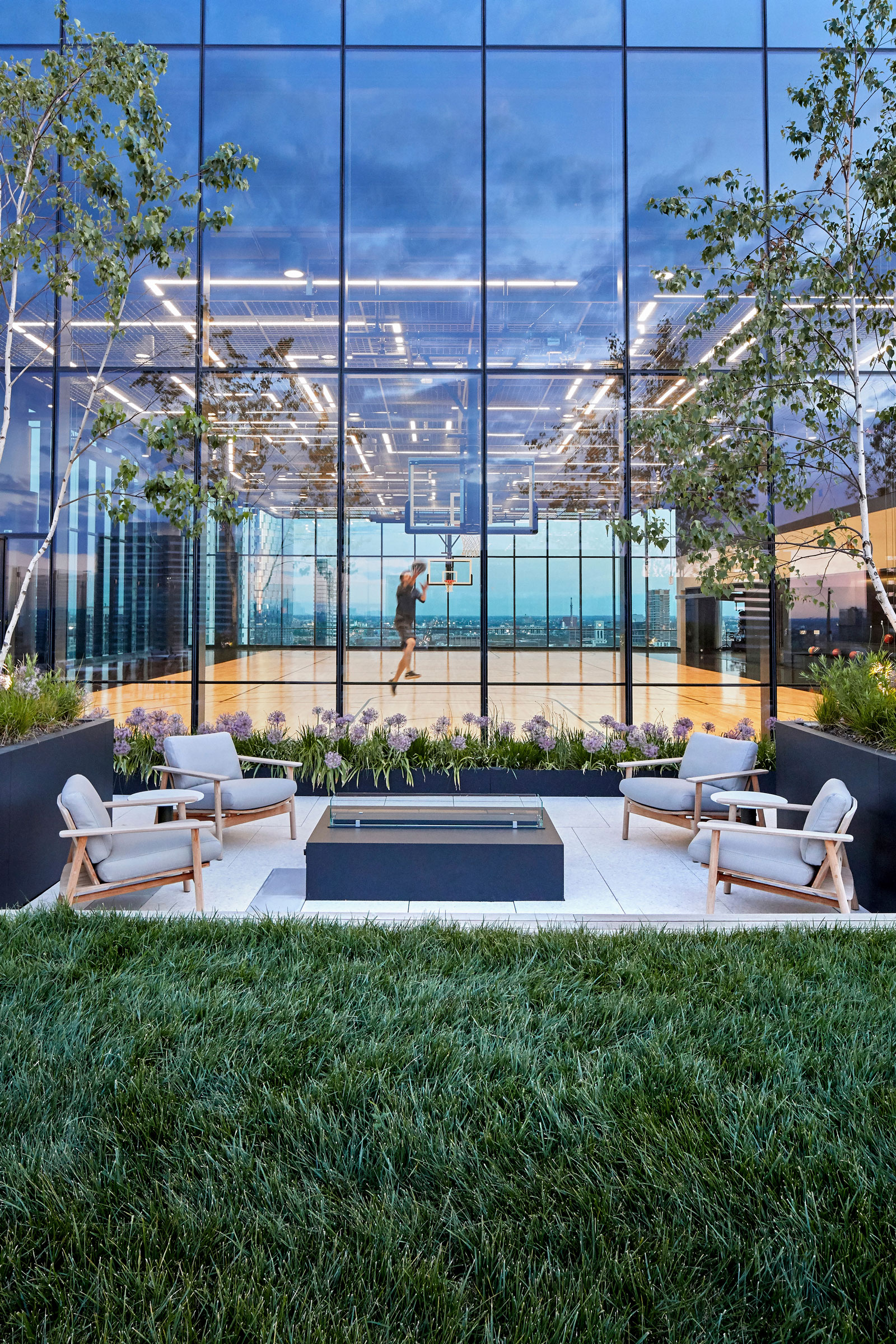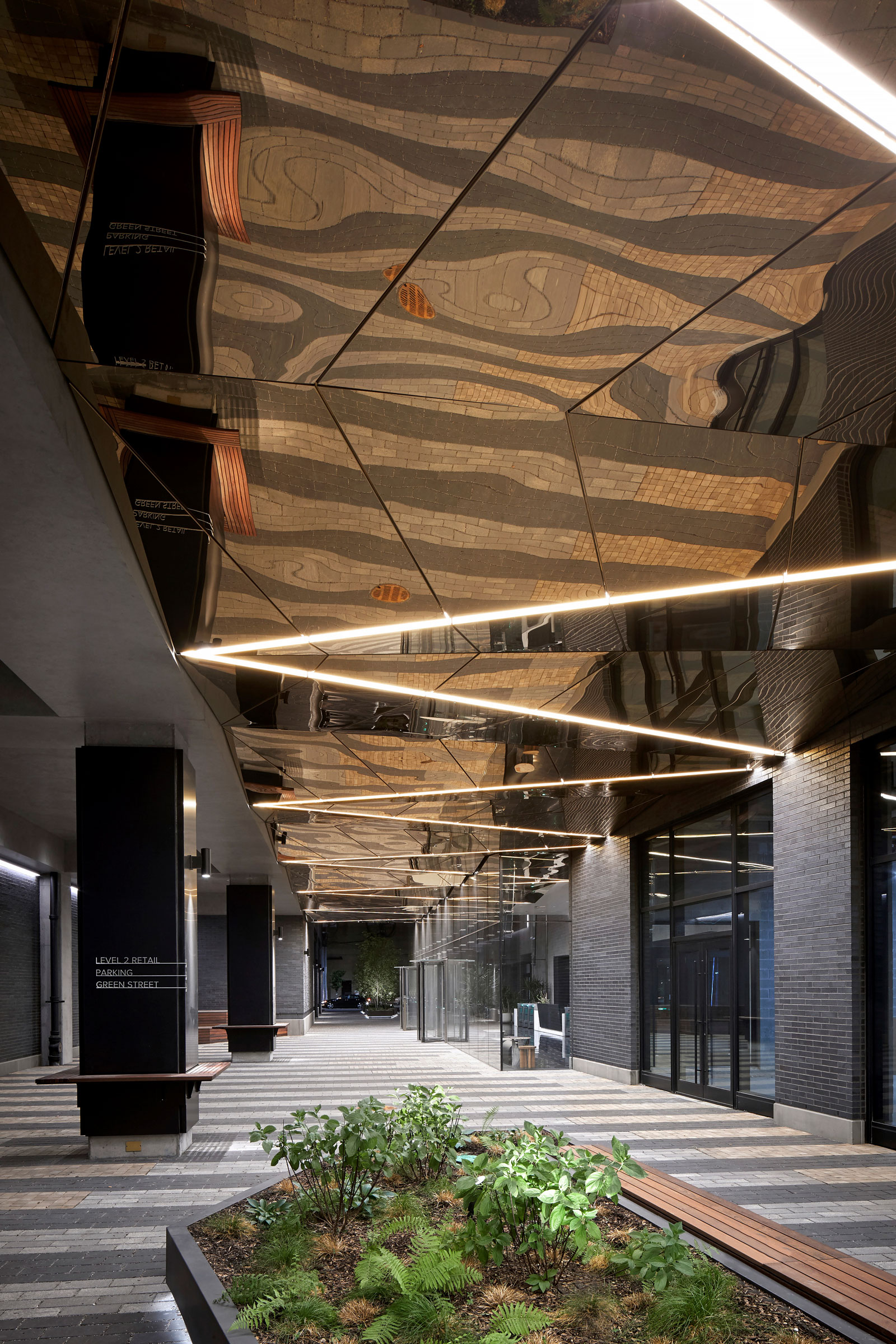Story at a glance:
- The line between indoors and out continues to blur as architects push the boundaries of inspiring outside design.
- Projects like 167 Green Street in Chicago, designed by Gensler and developed by Shapack and Focus, pushes outdoor views and access to the next level.
- Projects across higher ed, too, are showing a high demand for outdoor spaces with comfortable places to sit and hang out for hours.
- Efficient heating, tunable lighting, and shade solutions all factor in to the overall comfort of an outdoor space.
Buildings today are like ecosystems. They no longer stand alone, disconnected from their surroundings, serving one purpose. They do so much more. At least, that’s how Brian Vitale, co-managing director of Gensler Chicago, thinks of them.
“They are much more extroverted in that they’re always reaching out beyond their walls, right? The buildings are more porous—and not from a water standpoint.”
There’s no longer one way to enter, one exit, but there are multiple points of entry and egress and much more activity in modern commercial, higher ed, and even hospitality projects. “People love that connection between the interior and the exterior; that’s getting blurry. And that blurring is really important because people want to have that freedom.”
That persists year-round, too, even in places with four distinct seasons like Chicago. Take the 167 Green Street building in the hip West Loop/Fulton Market area in Chicago, for example. Designed by Gensler and developed by Shapack and Focus, the project pushes outdoor views and access to the next level, from the incredible roof deck to pockets of green space and connection to community—complete with a large outdoor space that hosts everything from food trucks to concerts. A firepit and comfortable outdoor furniture invite people to hang out, and there’s a feeling of liveliness, including art, at every turn. “There are little places for everyone to be,” Vitale says. “It’s so inviting, and you start to blur the line between indoors and outdoors because you can see everything.”
The most successful outdoor spaces are truly flexible, Vitale says. “You have to keep them almost purposely ambiguous because you want to be able to do a lot with them. You can’t just say, ‘This is where you sit, and this is where you eat.’”
Vitale says one area outside 167 Green has taken on a life of its own, and the possibilities are endless. “It’s no longer you go outside and you’re just outside. You can go out there and work. There’s Wi-Fi out there, there’s music, there’s food. It’s about extending these buildings outward.”
The LEED Gold 167 project is 750,000 square feet—13 floors of office space above two partial levels of parking and ground- and second-floor retail. The project is defined by a pedestrian-only thoroughfare that cuts through the building and connects to other streets bustling with dining and retail. On the roof deck with views of downtown Chicago an NBA size basketball court opens onto a large terrace with prairie plants.
Engaging Exteriors
- The roof deck of 167 Green Street offers views of downtown Chicago and an NBA size basketball court that opens onto a large terrace with prairie plants. Photo by Garrett Rowland
- Indoors and outdoors blend together seamlessly at the 167 Green Street property in Chicago. Photo by Garrett Rowland
He says that while blurring interior and exterior space is important and creating space that is flexible will make it more useful, defining boundaries also ensures the space will succeed.
“These boundaries can be defined by the building, hardscape, furniture, or landscape, all providing a sense of space and distance, not just vast openness. People want to understand their boundaries and feel the embrace of space,” he says.
When he thinks about successful outdoor designs, he looks to Mies van Der Rohe’s Barcelona Pavilion. Completed in 1929 the project seamlessly connects space and blurs the line between interior and exterior.
“The two become symbiotic and invite users to meander between them. This is what makes engaging exterior spaces—when they are treated as part of the design, not as leftover space,” Vitale says. “Some of these spaces may be designed with a specific function, but we see the most usable space being designed to be flexible, allowing for many types of uses and programs.”
Outside Education
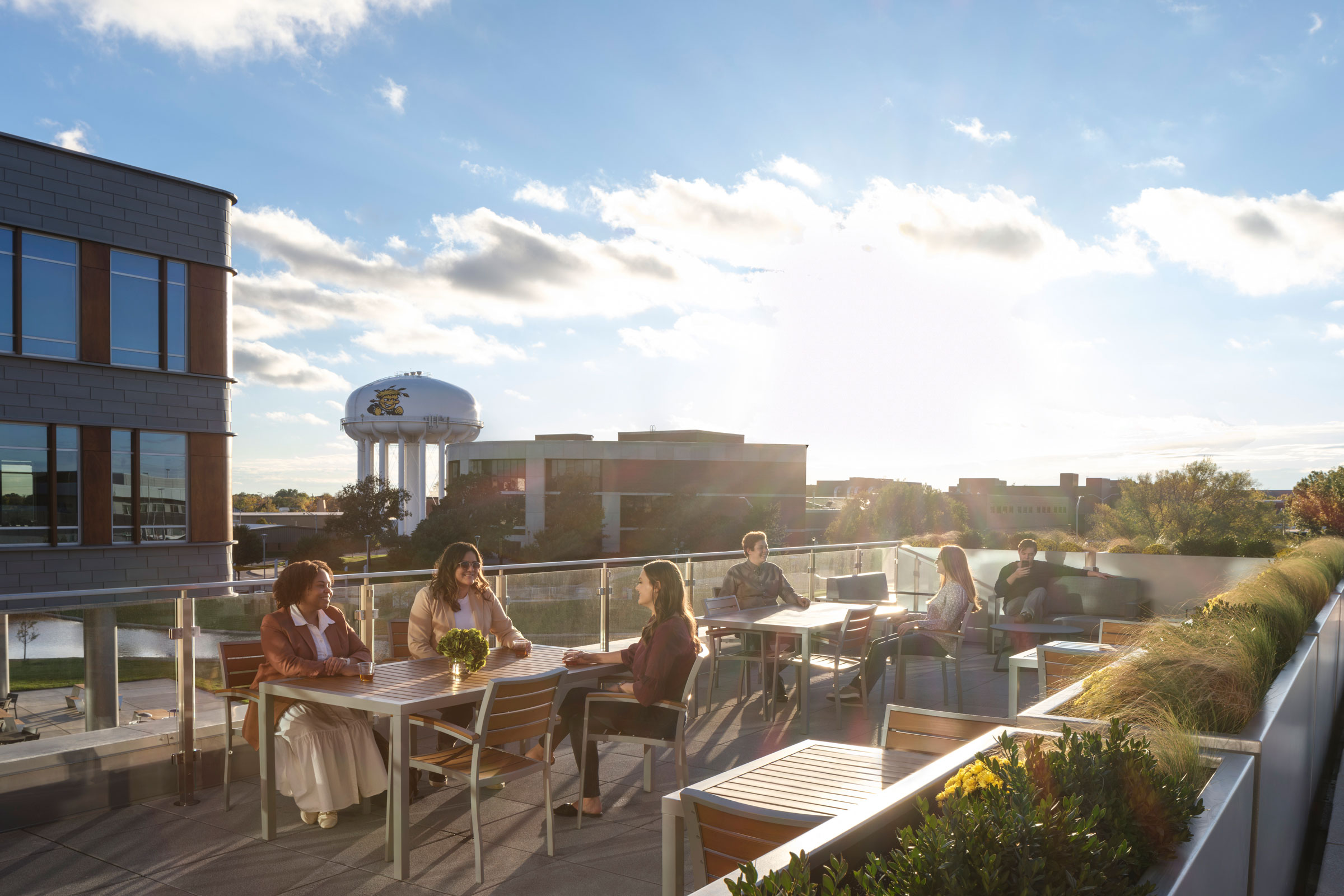
School designs like this Gensler project at Wichita State University are focusing more on preparing students for what’s next—including life in a potential bustling workplace. Photo by Jason O’Rear
Recent educational projects have also found success in designing flexible outdoor space, as many universities look to design environments that set students up for success after graduation. Many have taken inspiration from the design of modern commercial projects. “It’s a much easier transition for students to go into the workforce if they’re used to these types of spaces,” Vitale says, noting both the demand for exterior spaces and an emphasis on amenities.
Gensler recently completed a number of education projects that all heavily feature outdoor amenities, including work at the Wichita State University Barton School of Business, which includes a prominent bridge feature that doubles as a metaphor for a student’s academic journey. “The buildings in higher ed used to be very inwardly focused. It was all about focusing on the teacher. Now it is much more holistic; they want you to be engaged with what’s going on in your surroundings.”
But it doesn’t just stop at the building site, he says. The considerations continue, from what neighborhood a project is in to whether there is a great coffee shop nearby. What about a park? “That’s what I mean when I say these buildings are much more extroverted. They have to connect to their surroundings in a much different way than they used to, where we would just design pretty buildings and they would be their own thing.”
Collaboration starts early and includes partnering with landscape designers, he says, to ensure transitional spaces are just as thoughtfully considered. Gone are the days of simply walking from sidewalk to door to elevator. “We try to make that a much more experiential moment. You have this in-between moment,” Vitale says. “It’s like a porch on a house; you’re not part of the street, but you’re not inside the house. It’s working with the landscape designers to create not only the landscape but to create spaces so the building extends beyond its own four walls.”
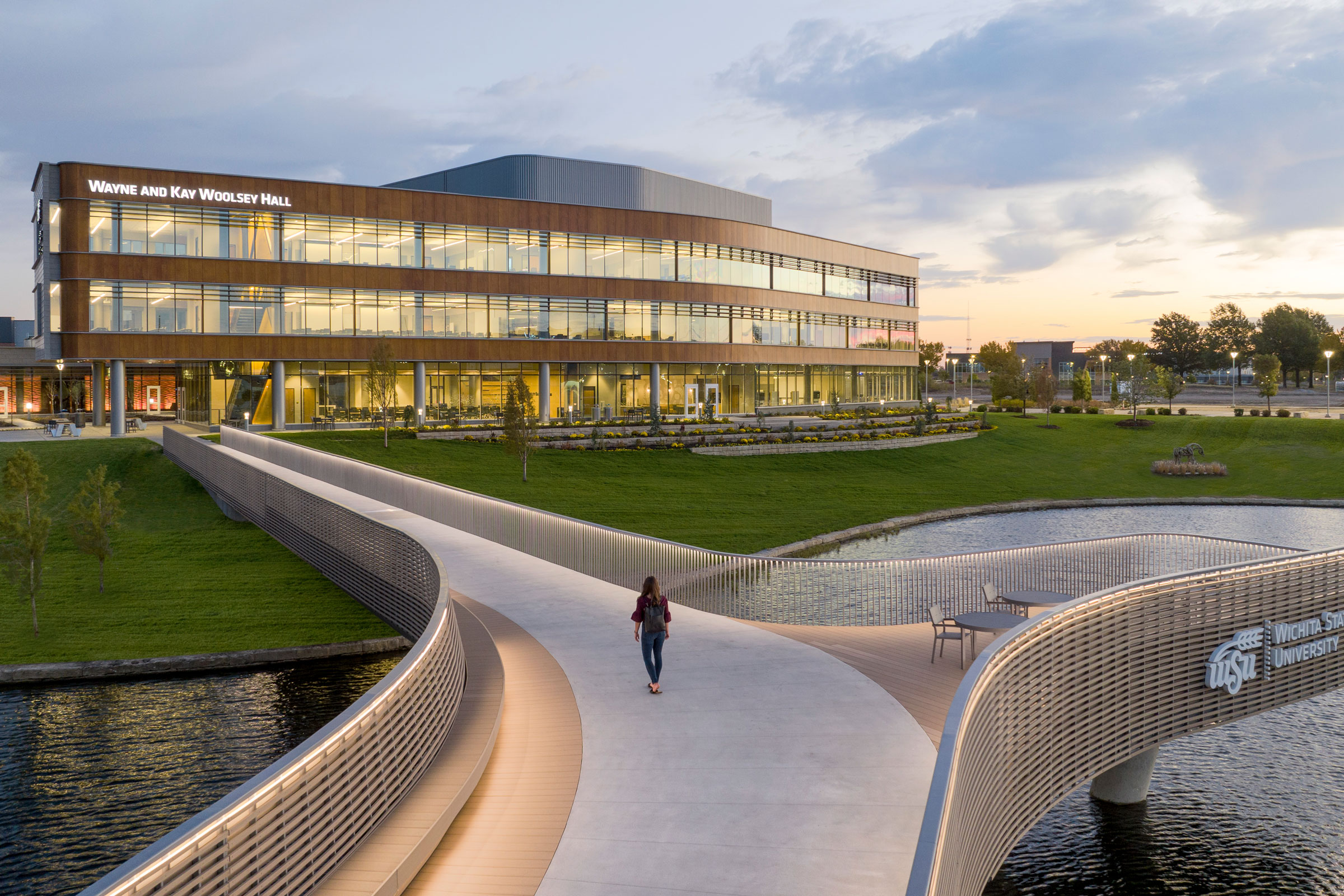
The WSU Barton School of Business includes a pedestrian bridge that offers multiple views and ways to experience the campus and landscape. Photo by Jason O’Rear
At Wichita State University Woolsey Hall the pedestrian bridge is all about meandering. “You can see it’s not a point A to point B bridge; rather it takes you in a much more experiential way around so you’re getting multiple views,” Vitale says. “When we’re thinking about outdoor spaces we’re not thinking about just creating this formal thing but about how do people experience it? This bridge takes them on a sort of curved journey so they’re seeing different points of the building and the landscape.”
There’s also a place where people can get off the circulation path but still be on the bridge to study, eat lunch, or just hang out. “The students will start to take these elements and make them their own. These things just happen naturally,” Vitale says, adding that it’s since become the top spot on campus for graduation photos.
The design team aims to create vistas that, yes, ultimately guide you or invite you to a place that’s welcoming, but also provide beautiful views and places to relax. Vitale likes to say not all architecture has windows and doors.
As people crave more time outside and even some classrooms move outdoors, he expects these conversations will continue to evolve. Architects and designers will keep looking for ways to make more flexible, inviting spaces—whether it’s for outdoor yoga or a safe place to protest. “We’re not necessarily designing the building, but we’re designing the experiences,” Vitale says.

